
 | | Brand new open diffs which have been removed at R&R & replaced with LSD's |
Our car has had a standard 'open' diff since we bought it. It does its job very well, but as you drive more and more, particularly on track, its limitations become apparent. The biggest manifestation of this is when exiting slow corners such as road junctions, or hairpins on track. In these situations it is quite common for the inside rear wheel to spin the power away as traction breaks. This becomes very frustrating - particularly on the track, where you can feel the power - and therefore speed - spin away. On our car with medium power this wheel spinning happens particularly on corners because the car is usually leaning, and the inner wheel has slightly less weight on it - exaggerating the wheel spin, or encouraging it to happen sooner. Certain tracks with lots of slow corners, such as Crois en Ternois, were becoming particularly frustrating - and tyres were wearing away rapidly!
 Standard diff as seen in our car. Half shafts have been removed. Cable is the handbrake cable. Top diff mounting bolt is visible, as is an oily (and short)breather tube, top left on the diff. Standard diff as seen in our car. Half shafts have been removed. Cable is the handbrake cable. Top diff mounting bolt is visible, as is an oily (and short)breather tube, top left on the diff.
The solution to these issues is fitting a Limited Slip Differential - or LSD. In the same situation as those described above, the LSD locks power to both wheels evenly - this gives much better traction out of corners. Because the power has been split evenly between both wheels, the wheel spinning is reduced and you take off. Of course if you have the power, this also means that both wheels can be made to spin, and wonderful power slides or donuts can be achieved!!
When attempting to do donuts with a standard open diff one will only be able to manage a series of figure of eight patterns on the 'road'! as soon as the car starts to slide around, the power is spun away by the inside wheel - turning the car the other way will prolong the slide the other way briefly, until the 'new' inner wheel also spins the power away - and so on. With a LSD fitted both wheels start to spin evenly and you can slide the car around continuously!
However, in the wet more caution must be exercised with a LSD. With a standard open diff fitted you have a form of traction control, where a skid induced by excessive power will be (relatively) harmlessly spun away by one wheel. With a LSD a power oversteer moment is much more likely - fun if you are expecting it, more dangerous if you are not!
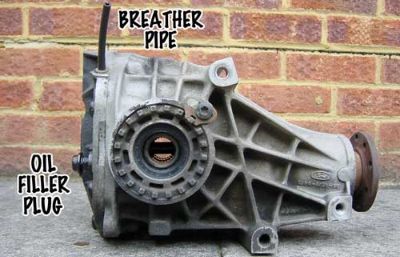 Our standard diff, removed from the car. Note the cross piece visible through the diff centre - this helps to identify the type of diff, as seen in my guide below. Our standard diff, removed from the car. Note the cross piece visible through the diff centre - this helps to identify the type of diff, as seen in my guide below.
I had managed to pick up a second hand LSD from Blatchat for £150. It was an AP Suretrac LSD, and had come from a Graduates Race car. New regulations had seen the whole field have to change to a new ZF type diff, so this was a bargain. It would have been possible to simply swap the LSD into our current diff casing but I wanted to keep our original diff as it was (as a 'spare') so I needed another diff case. Another lucky Blatchat break got me a 2nd hand diff case for £50, so all I had to do now was get the 'new' LSD assembled.
 Road & Race Transmissions - located in a bullock shed (that is their address!) on a farm in Kent - wondrous things exist inside (if you like cogs and gears that is!) Road & Race Transmissions - located in a bullock shed (that is their address!) on a farm in Kent - wondrous things exist inside (if you like cogs and gears that is!)
Universal recommendations pointed to Road and Race Transmissions in Kent as the right guys for the job. Phil is a Caterham racer with years of experience in correctly setting up diffs for Caterhams. Not only that, but they were reasonably priced and would do the job while I waited. So I headed out into the countryside with my second hand LSD and case...
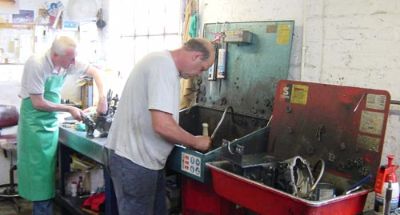 Phil and at work inside their workshop. Phil and at work inside their workshop.
 Standard diff being removed from my 2nd hand casing - here the back plate has been removed. Standard diff being removed from my 2nd hand casing - here the back plate has been removed.
 All the dismantled components are cleaned and checked before being re-used. All the dismantled components are cleaned and checked before being re-used.
 Phil cleaning! Phil cleaning!
 This is a standard open diff, as found in most normal cars. The large crown wheel is removed and used on the new LSD. This is a standard open diff, as found in most normal cars. The large crown wheel is removed and used on the new LSD.
 Inside the casing with diff removed and before cleaning. Inside the casing with diff removed and before cleaning.
I had hoped for a straight swap, but having removed the old diff Phil recommended that I replace the bearings for the pinion - the point where the connection from the drive shaft enters the diff. The bearings were 'ok' but a little 'grindy' - Phil advised that they may therefore be a little noisy. As he had already established that the new LSD was in good condition, it seemed a shame to skimp, so despite trying to do this on a budget I decided to spend the extra £100 or so replacing these bearings - that way I was getting an almost new LSD which would still be less than half price of a new one.
 Input shaft into the diff. Flange (just visible bottom right of shot) is fitted onto this, and this then bolts to the drive shaft via a universal joint. Input shaft into the diff. Flange (just visible bottom right of shot) is fitted onto this, and this then bolts to the drive shaft via a universal joint.
 Tightening up new bearings. Tightening up new bearings.
 Inside the cleaned out diff casing, showing the pinion. Inside the cleaned out diff casing, showing the pinion.
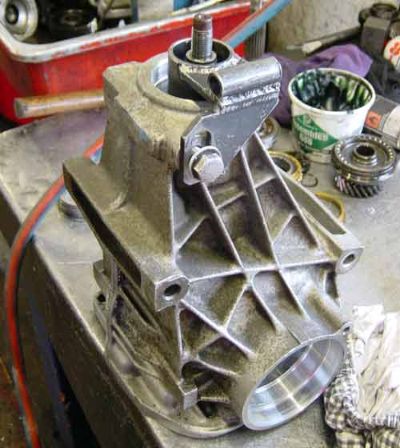 Special bracket ensure correct and centred fitting of the new bearings. Special bracket ensure correct and centred fitting of the new bearings.
 'New' LSD with the crown wheel bolted on, and now ready to install back into the casing. 'New' LSD with the crown wheel bolted on, and now ready to install back into the casing.
 New LSD in situ. New LSD in situ.
 Using some Engineers Blue, Phil checked that the crown wheel and pinion were meshing properly and that neither was too worn. Using some Engineers Blue, Phil checked that the crown wheel and pinion were meshing properly and that neither was too worn.
 If you look closely you can see the mark left by the 2 sets of teeth meshing - a nice wide mark means a larger surface area of contact - proving that there was little wear and a good 'mesh'. If you look closely you can see the mark left by the 2 sets of teeth meshing - a nice wide mark means a larger surface area of contact - proving that there was little wear and a good 'mesh'.
 One of R&R's back rooms - if you want anything to do with transmissions, diffs, gearboxes etc - give Phil a call - chances are that they will have what you need, and know what to do with it! One of R&R's back rooms - if you want anything to do with transmissions, diffs, gearboxes etc - give Phil a call - chances are that they will have what you need, and know what to do with it!

Whilst I was at R&R Phil was very happy for me to take lots of pictures. He suggested that I put a small 'diff guide' on the website, as a very common question he hears is 'What sort of diff do I have?'
There are a few different types of diff, some work in different ways, and some are more suitable for certain applications, certain levels of power, or certain uses.
The AP Suretrac diff will be fine for our car. For cars with more than 150bhp Phil advises that you use a different type of diff, such as the ZF, which is better at handling bigger power levels in certain situations, such as kerb hopping on race tracks. A quick telephone call to Phil and he will be able to advice specifically, but this guide may help with initial identification.
There is an easy way to identify the type of diff - after removing the half shafts, have a look through the diff - what you see will tell you what type of diff you have, as shown below:

 Standard 'Open diff' (shown outside the diff casing) Standard 'Open diff' (shown outside the diff casing)
 'AP Suretrac' LSD - this is the type we now have fitted in our car. 'AP Suretrac' LSD - this is the type we now have fitted in our car.
 A cross shape inside indicates that this diff is a 'ZF' LSD. A cross shape inside indicates that this diff is a 'ZF' LSD.
 Again shown outside the casing, a smaller central hole indicates that this is a Quaiffe LSD. Again shown outside the casing, a smaller central hole indicates that this is a Quaiffe LSD.

If you ask someone who knows how each type of LSD works, chances are they will give you a pretty good description about how an open diff works - its just cogs - how a ZF works - plates and things - and how a ZF works. But ask how an AP Suretrac works and you will likely get the answer 'Ah well - it's just sort of magic - it just sort of works....'
It just so happens that Mark has just had to replace his broken AP diff with a new ZF diff (he has considerably more than 150bhp) so I knicked his old AP diff and took it apart to see if I could see what all this 'magic' was all about. I don't pretend to be any closer to knowing how it works (it just does) but it is pretty cool to see inside and try and figure it out....
 Naked AP Suretrac LSD -crown wheel has been removed already. Naked AP Suretrac LSD -crown wheel has been removed already.
 LSD split into 2, revealing bearings and oil runs on bearing surfaces - nothing fancy or magic so far.... LSD split into 2, revealing bearings and oil runs on bearing surfaces - nothing fancy or magic so far....
 See... See...
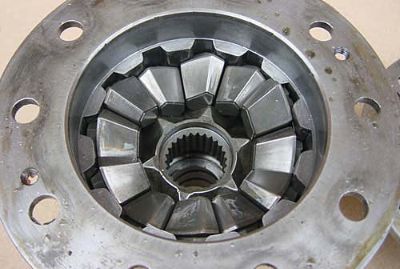 WHOAH!!! - what is that?? This is where the magic bit starts - lots of weirdly shaped nuggets of metal - it looks like a Rubics (remember them) puzzle of some sort - or a hand grenade?! WHOAH!!! - what is that?? This is where the magic bit starts - lots of weirdly shaped nuggets of metal - it looks like a Rubics (remember them) puzzle of some sort - or a hand grenade?!
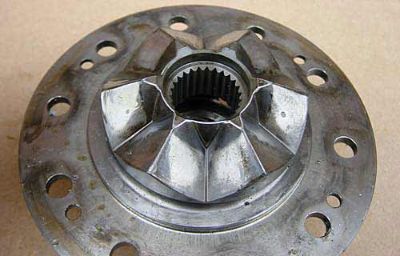 This is the underside of the plate that was removed to expose the nuggets. If you like 'stuff' and gears and machines, this is a cool shape!! This is the underside of the plate that was removed to expose the nuggets. If you like 'stuff' and gears and machines, this is a cool shape!!
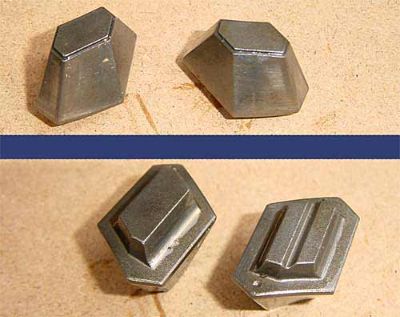 The nuggets - there are 2 different types - the groove on the back shows the difference. The 'spine' on the back of these shapes locates in grooves inside the LSD casing, and slide up and down these grooves. The nuggets - there are 2 different types - the groove on the back shows the difference. The 'spine' on the back of these shapes locates in grooves inside the LSD casing, and slide up and down these grooves.
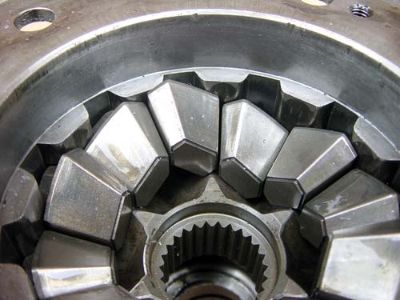 Close up of nuggets in-situ. The splined bit is where the half shafts will engage in the diff. Close up of nuggets in-situ. The splined bit is where the half shafts will engage in the diff.
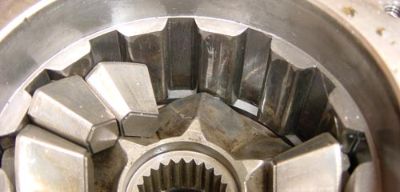 A few nuggets removed to show the grooves that they move up and down in as the diff turns. A few nuggets removed to show the grooves that they move up and down in as the diff turns.
I would love to understand the thought process of the engineer who came up with this, and then managed to actually draw the thing in order to make it as well!
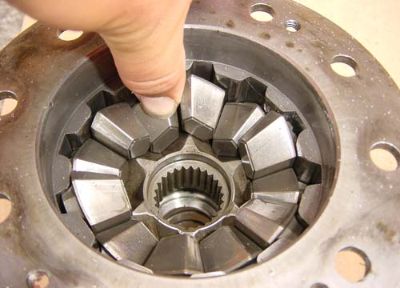 Ok - now this is hard to explain, but as the drive shaft rotates the nuggets move up and down in a sort of 'Mexican Wave' way - this is as close as I have got to describing the movement!! Ok - now this is hard to explain, but as the drive shaft rotates the nuggets move up and down in a sort of 'Mexican Wave' way - this is as close as I have got to describing the movement!!
I don't know what 'wears' in an AP LSD, but I suspect the surface condition and wear of these 'nuggets' and the shapes which they run in are pretty tightly tolerenced.
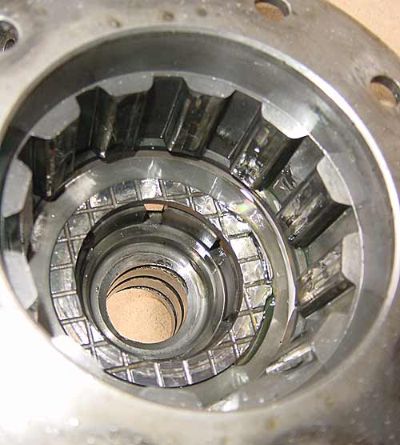 LSD inners removed, showing the other end with bearing surfaces, as seen on the other plate. Better view of the big grooves that the nuggets move up and down in as well. LSD inners removed, showing the other end with bearing surfaces, as seen on the other plate. Better view of the big grooves that the nuggets move up and down in as well.
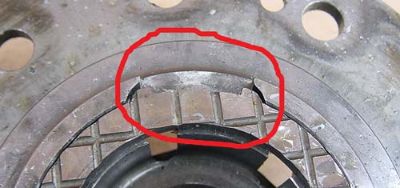 Now I am not sure what happens when an AP LSD stops working, or why it stops being affective, but I did find this on Marks old diff. See this location tab - this is what it should look like... Now I am not sure what happens when an AP LSD stops working, or why it stops being affective, but I did find this on Marks old diff. See this location tab - this is what it should look like...
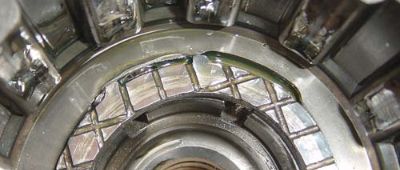 But on the other end it had been jammed out of position - may be nothing, but it would have had some effect... But on the other end it had been jammed out of position - may be nothing, but it would have had some effect...
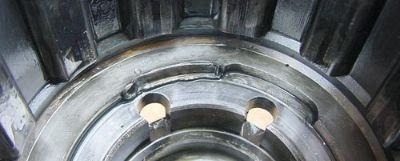 Better view of the damage with the spacer, or grooved 'washer' removed. Better view of the damage with the spacer, or grooved 'washer' removed.
 Oops - this is what happens if you just undo the bolts and pull - lots of odd shaped bits of metal fall all over the floor - and unless you saw where and how they located before they all fell out, you are probably stuffed!!! Oops - this is what happens if you just undo the bolts and pull - lots of odd shaped bits of metal fall all over the floor - and unless you saw where and how they located before they all fell out, you are probably stuffed!!!
Thanks to Phil at Road & Race for letting me take all the pictures and taking the time to show me around their workshops - I have no hesitation in recommending Road & Race for any work you need doing, and they are also very free with their advice - another friendly supplier to add to the list!!
Road & Race Transmissions
The Bullock Shed
Filston Farm
Shoreham, Kent
TN14 5JU
tel: 01959 525105
mobile: 07836 333882 |
| 

